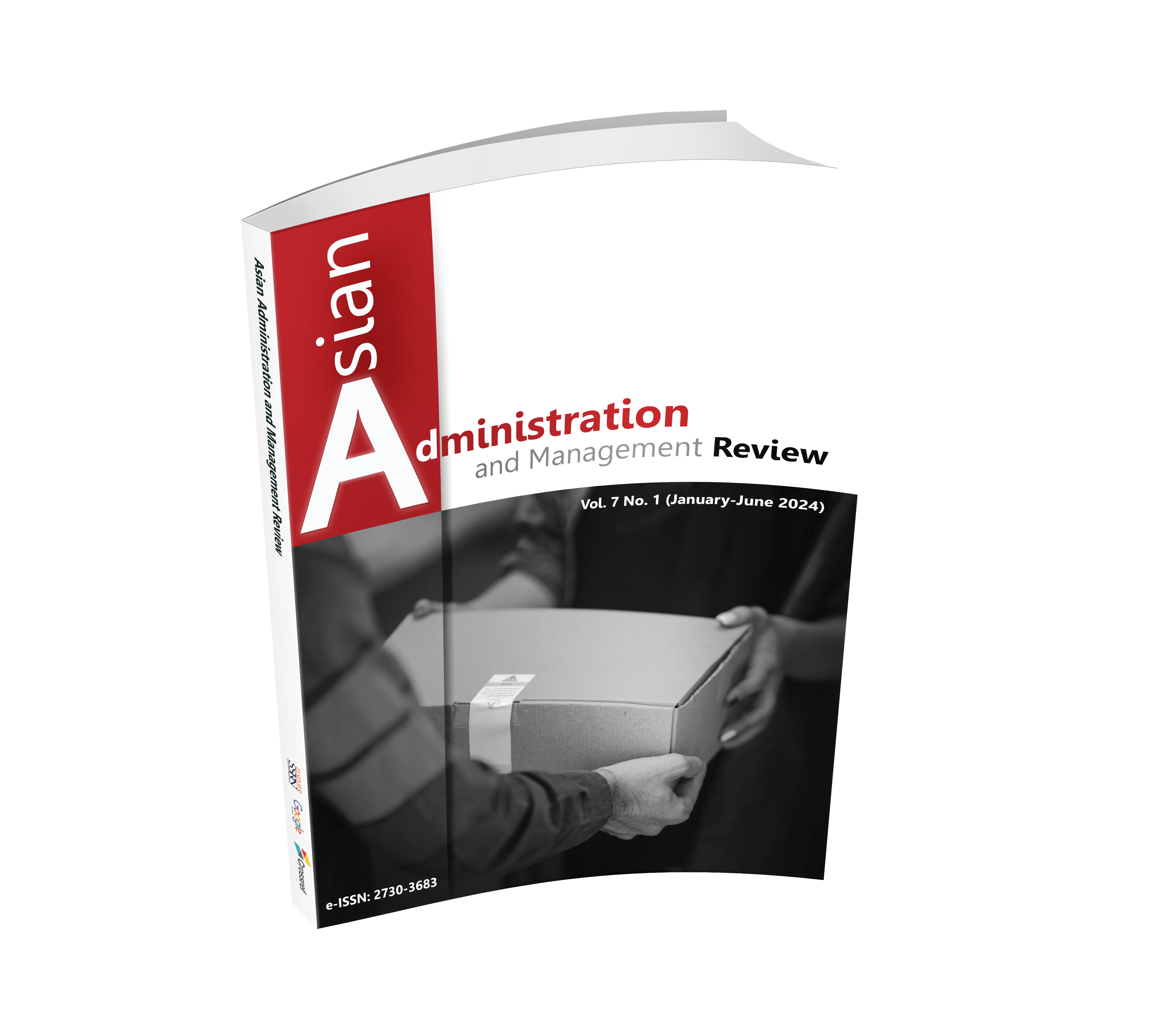DEVELOPING VALUE CHAIN MANAGEMENT OF COMMUNITY BUSINESS PROCESSING MULBERRY PRODUCTS IN YALA, THAILAND
DOI:
https://doi.org/10.14456/aamr.2024.5Keywords:
Value Chain Management, Community Enterprise, Processing Mulberry ProductsAbstract
This research aims to 1) study the value chain management of mulberry processing community businesses in Yala, Thailand and 2) develop a mulberry processing community business in the province according to the value chain management model. Data were collected through group interviews and focus group discussions. Interviews were conducted with five group leaders, and development efforts were undertaken with four members of the selected group. The research also involved interviews with five marketing intermediaries, observations, and the distribution of questionnaires to 100 sample consumers using convenience sampling. Content analysis was employed to analyze qualitative data, while descriptive statistics were utilized for quantitative data analysis. The findings revealed that members are responsible for purchasing raw materials and delivering goods themselves. Most of them sell their products through marketing intermediaries. Members also handle income and expense accounts while continuously enhancing the production skills of group members. The development of the value chain focuses on enhancing the efficiency of all value chain activities, with particular emphasis on production, marketing and sales, and human resource management activities. Following the development initiatives, the group experienced a 25 percent increase in income and attracted more customers, particularly through online sales channels such as Facebook. The group also streamlined its internal business processes. Furthermore, group members acquired online marketing skills and expanded their product range to include items like mulberry buns and mulberry juice mixed with dates. However, group members need to maintain vigilance and continually refine their activities within the business value chain.
Downloads
References
Awan, U., Sroufe, R., & Bozan, K. (2022). Designing Value Chains for Industry 4.0 and a Circular Economy: A Review of the Literature. Sustainability, 14(12), 7084.
Chao, M., Seo, M., & Kim, J. (2022). Impacts of marketing capabilities on competitive advantage and business performance: Application of IPMA. The Korean Journal of Franchise Management, 13(1), 19-33.
George, D., & Mallery, P. (2016). IBM SPSS Statistics 23 Step by Step: A Simple Guide and Reference. 14th ed. New York: Routledge.
Hongvattanajainam, S., & Luanchamroen, S. (2022). Strategic management approach to create a competitive advantage in the Thailand 4.0 of SMEs, the automation service provider in Thailand. Ph.D. in Social Sciences Journal, 12(3), 561-574.
Jantasart, R., Buchaiyaphum, T., Promngam, P., Sengupta, G., & Yimcharoenpornsaku, N. (2022). Causal relationship factor competitiveness supply chain operations for entrepreneurs’ performance in the new normal. Interdisciplinary Sripatum Chonburi Journal, 8(2), 16-30.
Jintana, S., & Puripanik, T. (2020). A Problem, Limitations and Approaches for Strengthening of Community-Based Enterprises in Thailand. Journal of Politics, Administration and Law, 12(3), 179-194.
Jun, I., & Rowley, C. (2019). Competitive advantage and the transformation of value chains over time: The example of a South Korean diversified business group, 1953-2013. Business History, 61(2), 343-370.
Kaplan, R., & Norton, D. (2006). Alignment: Using the Balanced Scorecard to Create Corporate, Synergies. Massachusetts: HBS Press.
Lawless, H., & Heymann, H. (2010). Sensory Evaluation of Food Science Principles and Practices. 2nd ed. New York: Ithaca.
Maneerat, P., & Jaroenwisan, K. (2022). Value Chain Model for Value Addition of Local Ingredients to Gastronomy Tourism’s Activities in Phuket Province. Journal of Multidisciplinary in Humanities and Social Sciences, 5(3), 813-825.
Nawawi, M., Ali, A., Irawan, B., Ahmad, B., Mukramin, S., Marsuki, N., Umanailo, M., & Kaya, I. (2020). The Village Kalesang Program as a Poverty Alleviation Community. International Journal of Scientific & Technology Research, 9(3), 3103-3107.
Nithichaianan, N., & Chidchob, T. (2022). The Guidance to Develop Capabilities and Competitiveness of Community Businesses to Support Community Economies Toward Stability and Sustainability: A Case Study of Community Businesses in Kap Choeng District, Surin Province. Research and Development Institute, Loei Rajabhat University, 17(59), 84-92.
Nurjaya, N., Affandi, A., Erlangga, H., Sunarsi, D., & Jasmani, J. (2021). The effect of product promotion and innovation activities on marketing performance in middle small micro enterprises in Cianjur. Budapest International Research and Critics Institute-Journal, 4(1), 528-540.
Office of the National Economic and Social Development Board. (2021). The Thirteenth National Economic and Social Development Plan Framework. Bangkok: Office of the National Economic and Social Development Board.
Panomupatam, C. (2022). Product Innovation and the Primary Activities of the Value Chain that Affect to Performance of Community Enterprises Operating Herbal Products in Thailand. Journal of Social Innovation and Mass Communication Technology, 5(2), 64-77.
Phrapratanporn, B., Wararatchai, P., Aunyawong, W., & Rashid, N. (2019). Enhancing Supply Chain Performance of SMEs in Thailand Using the Integrated Personnel Development Model. International Journal of Supply Chain Management, 8(5), 176-186.
Porter, M. (1985). Competitive Advantage: Creating and Sustaining Superior Performance. New York: Free Press.
Prasetyo, P., & Dzaki, F. (2020). Institutional performance and new product development value chain for entrepreneurial competitive advantage. Uncertain Supply Chain Management, 8(4), 753-760.
Scholtes, F., Neff, D., & Lampe, F. (2018). The Role and Sources of Agency and Self-Employment Over the Life Course: Micro-Entrepreneurs in Kampala, Uganda. Journal of Developmental Entrepreneurship, 23(4), 1-21.
Sinha, R., & Ola, A. (2021). Enhancing business community disaster resilience: A structured literature review of the role of dynamic capabilities. Continuity & Resilience Review, 3(2), 132-148.
Sriphong, C., Kachonkitiya, N., & Esor, A. (2022). Value Chain Management and Business Performance of One Tambon One Product Businesses in the Southernmost Province of Thailand. Journal of Positive School Psychology, 6(4), 8706-8702.
Teguh, S. (2021). Innovation Capability and Sustainable Competitive Advantage: An Entrepreneurial Marketing Perspective. Journal of Asian Finance, Economics and Business, 8(5), 127-134.
Waiyawuththanapoom, P., Thammaboosadee, S., Tirastittam, P., Jermsittiparsert, K., Wongsanguan, C., Sirikamonsin, P., & Aunyawong, W. (2022). The role of human resource management and supply chain process in sustainable business performance. Uncertain Supply Chain Management, 10(2), 517-526.
Watcharakiettisak, T., Lertyingyot, S., & Ritthaisong, Y. (2019). Business Success Model Development for Micro Enterprise. Journal of Business Administration, The Association of Private Higher Education Institutions of Thailand, 8(2), 118-141.
Widhayanantanarom, P., & Ayasanond, C. (2021). The Approach to Develop Value Chain Management of Ready Coconut Milk Business. Journal of Logistics and Supply Chain College, 7(1), 141-156.
Yodkaew, N., Pongyeela, A., & Kumsuprom, S. (2021). Factors Affecting the Sustainable Performance of Rice Cooperative in Thailand. Journal of MCU Peace Studies, 9(6), 2424-2439.

Downloads
Published
How to Cite
Issue
Section
License
Copyright (c) 2023 Authors

This work is licensed under a Creative Commons Attribution-NonCommercial-NoDerivatives 4.0 International License.











.png)


